Indian men’s fashion boasts a rich tapestry of traditional and contemporary styles, reflecting the country’s diverse cultural heritage. From elegant sherwanis to comfortable kurtas, these garments have evolved over centuries, showcasing a blend of tradition and modernity. This blog post will explore ten of the most famous dresses for men in India, each with its own unique history, cultural significance, and enduring appeal.
10. Angrakha
- Origin: The angrakha is a traditional Indian garment with a distinctive diagonal closure.
- Key Characteristics: Typically made of cotton or silk, the angrakha is often adorned with intricate embroidery and embellishments.
- Cultural Significance: The angrakha is a symbol of Indian heritage and is often worn during festivals and special occasions.
The angrakha is a traditional Indian garment with a rich history and a distinctive style.
Key Characteristics:
- Asymmetrical Closure: The most defining feature of the angrakha is its asymmetrical closure. It’s typically fastened on the left shoulder or left side of the chest, creating a diagonal overlap.
- Versatile Design: Angrakhas can come in various lengths, from short kurtas to long coats.
- Fabric Choices: Traditionally made from cotton and silk, modern angrakhas can be found in a variety of fabrics, including linen, velvet, and even lighter materials like chiffon.
- Embellishments: Angrakhas are often adorned with intricate embroidery, beadwork, and other embellishments, adding to their visual appeal.
Historical Significance:
- Ancient Roots: The angrakha has deep roots in Indian history, with evidence of similar garments worn in ancient times.
- Royal Connections: It was particularly popular among royalty and nobility in various parts of India, reflecting its regal and elegant nature.
- Cultural Significance: The angrakha represents a blend of comfort and style, reflecting the rich cultural heritage of India.
Modern Interpretations:
- Contemporary Designs: Modern designers have reimagined the angrakha, incorporating contemporary elements like asymmetrical cuts, bold colors, and innovative designs.
- Versatility: Today, angrakhas are not just confined to formal occasions. They can be styled for various events, from casual outings to weddings and festivals.
- Gender-Neutral Appeal: While traditionally worn by men, angrakhas have gained popularity among women as well, with designers creating elegant and stylish versions for the female wardrobe.
Cultural Impact:
- Symbol of Heritage: The angrakha continues to be a symbol of Indian heritage and cultural identity.
- Fashion Inspiration: Its unique design and aesthetic have influenced contemporary fashion, inspiring designers to create innovative and fusion wear.
Conclusion:
The angrakha is more than just a garment; it’s a testament to the enduring beauty and cultural richness of Indian fashion. Its unique design, historical significance, and versatility ensure that the angrakha will continue to be a cherished and celebrated piece of Indian attire for generations to come.

9. Dhoti-Pant
- Origin: The dhoti-pant is a modern interpretation of the traditional dhoti, combining its comfort with a more contemporary look.
- Key Characteristics: It resembles a pair of trousers with a draped effect, offering a unique and stylish alternative to traditional pants.
- Versatility: The dhoti-pant can be paired with a kurta, shirt, or even a T-shirt, creating a variety of looks.
The dhoti-pant is a modern interpretation of the traditional dhoti, a garment with a long and rich history in Indian culture.
Key Characteristics:
- Fusion of Tradition and Modernity: Dhoti pants seamlessly blend the essence of the traditional dhoti with the comfort and practicality of modern trousers.
- Appearance: They resemble a pair of trousers with a draped effect, often featuring pleats or folds around the front or sides, reminiscent of the way a dhoti is traditionally draped.
- Fabric: Dhoti pants can be made from a variety of fabrics, including cotton, linen, silk, and blends, offering both comfort and style.
- Versatility: They can be paired with a range of tops, including kurtas, shirts, tunics, and even t-shirts, creating a versatile and stylish look.
How they differ from traditional Dhotis:
- Ease of Wear: Dhoti pants are generally easier to wear and maintain compared to traditional dhotis, which often require more intricate draping techniques.
- Modern Aesthetics: They incorporate modern design elements and silhouettes, making them more suitable for contemporary lifestyles.
- Comfort and Convenience: Dhoti pants offer a comfortable and convenient alternative to traditional dhotis, especially for daily wear and casual occasions.
Styling Dhoti Pants:
- Casual: Pair dhoti pants with a simple t-shirt or a casual shirt for a relaxed and comfortable look.
- Formal: Pair dhoti pants with a kurta or a long-sleeved shirt for a more formal and elegant look.
- Accessorize: Add accessories like a shawl, scarf, or jewelry to complete the look.
- Footwear: Pair dhoti pants with mojaris, sandals, or even sneakers for a contemporary twist.
Cultural Significance:
- Modern Interpretation: Dhoti pants represent a modern interpretation of a traditional Indian garment, bridging the gap between tradition and contemporary fashion.
- Cultural Fusion: They showcase the fusion of traditional Indian aesthetics with modern sensibilities.
Conclusion:
Dhoti pants offer a unique and stylish blend of tradition and modernity. They are a comfortable, versatile, and fashionable option for men who want to embrace their cultural heritage while embracing contemporary trends.
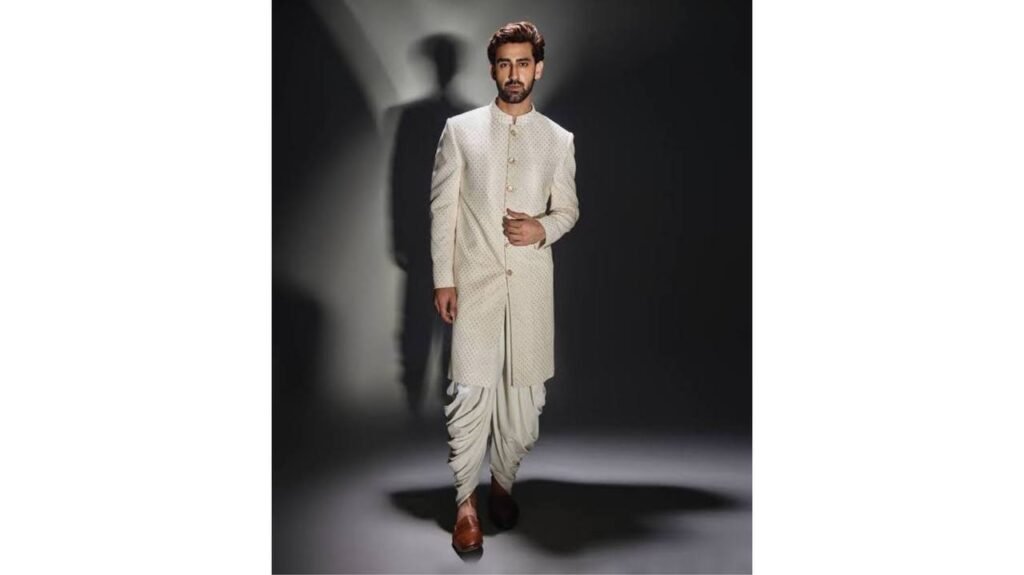
8. Kurta with Jeans
- Origin: A classic combination of traditional and modern, the kurta paired with jeans is a versatile and comfortable option for casual wear.
- Key Characteristics: The kurta can be paired with different styles of jeans, from slim-fit to relaxed fit, creating a variety of looks.
- Versatility: This combination is suitable for a wide range of occasions, from casual outings to semi-formal events.
The kurta with jeans is a classic example of Indo-Western fusion, seamlessly blending traditional Indian attire with a contemporary Western staple. This combination has gained immense popularity in recent years, offering a stylish and comfortable option for men of all ages.
Key Aspects of the Kurta with Jeans Look:
- Versatility: This combination is incredibly versatile and can be adapted for various occasions, from casual outings and social gatherings to semi-formal events.
- Comfort: The combination of a loose-fitting kurta and comfortable jeans offers unparalleled comfort and ease of movement.
- Style Flexibility:
- Casual: Pair a short-length cotton kurta with distressed jeans and sneakers for a relaxed, everyday look.
- Semi-Formal: Opt for a longer, silk or linen kurta with straight-leg jeans and leather shoes for a more sophisticated look.
- Festive: Experiment with embellished kurtas, such as those with embroidery or prints, and pair them with dark-wash jeans for a festive touch.
- Color Combinations:
- Classic: White or cream kurta with blue jeans is a timeless and versatile combination.
- Bold: Experiment with contrasting colors, such as a black kurta with grey jeans or a red kurta with black jeans.
- Subtle: Opt for subtle color combinations like a beige kurta with light blue jeans or a blue kurta with grey jeans.
Styling Tips:
- Accessorize: Enhance the look with accessories like a watch, sunglasses, and a scarf.
- Footwear: Choose appropriate footwear based on the occasion. Sneakers, loafers, and even ethnic footwear like juttis can complement the look.
- Experiment with Lengths: The length of the kurta can significantly impact the overall look. Experiment with short, knee-length, and ankle-length kurtas to find the style that suits you best.
- Consider the Fit: Ensure the kurta fits well and is not too tight or too loose. The jeans should also fit comfortably and flatter your body shape.
Cultural Significance:
- Fusion of Traditions: The kurta with jeans represents a fusion of Indian and Western styles, reflecting the evolving fashion landscape in India.
- Modern Interpretation: It offers a contemporary take on traditional Indian attire, making it accessible and appealing to a wider audience.
Conclusion:
The kurta with jeans is a stylish and versatile outfit that seamlessly blends tradition with modernity. Its comfort, versatility, and ease of styling have made it a popular choice for men of all ages, reflecting the evolving fashion trends in India.
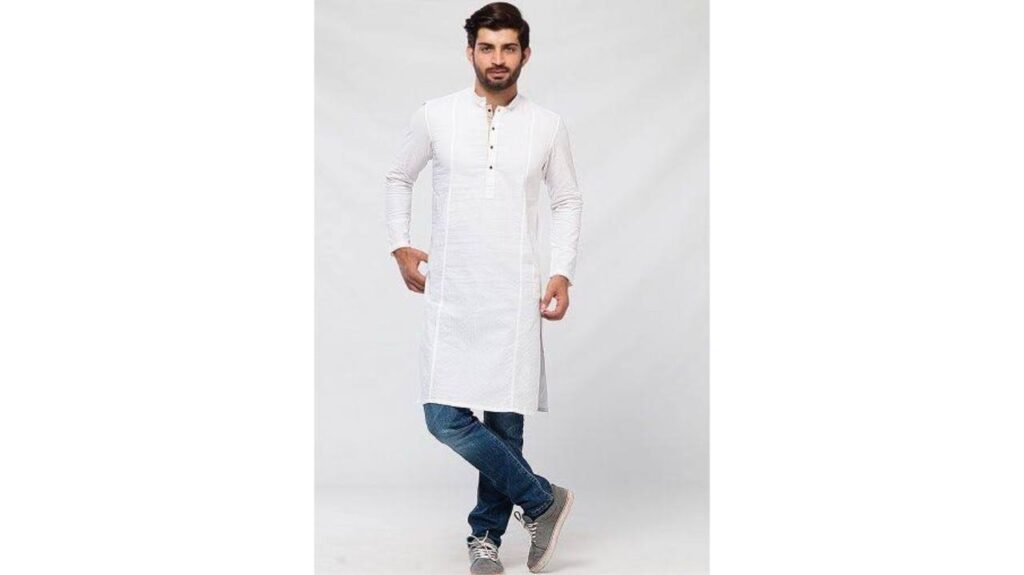
7. Indo-Western Fusion
- Origin: Indo-Western fusion wear combines traditional Indian elements with Western styles.
- Key Characteristics: This category encompasses a wide range of garments, including kurtas with jeans, sherwanis with Western cuts, and dhoti pants paired with modern shirts.
- Versatility: Indo-Western fusion wear offers a contemporary take on traditional Indian attire, making it suitable for a variety of occasions.
- Cultural Significance: Indo-Western fusion wear reflects the evolving fashion landscape in India, showcasing a blend of tradition and modernity.
Indo-Western Fusion Wear for Men: A Blend of Tradition and Modernity
Indo-Western fusion wear represents a dynamic and evolving segment of Indian men’s fashion, seamlessly blending traditional elements with contemporary styles. This unique category reflects the changing cultural landscape and the desire for a more modern and versatile wardrobe.
Key Characteristics:
- Fusion of Styles: The hallmark of Indo-Western fusion is the harmonious blending of traditional Indian elements with Western fashion aesthetics.
- Examples: This can involve incorporating Indian motifs like embroidery, beadwork, and prints into Western silhouettes such as jackets, shirts, and trousers.
- Variations: The fusion can be subtle, such as adding Indian embroidery to a classic blazer, or more pronounced, like combining a traditional kurta with tailored trousers.
- Versatility: Indo-Western fusion wear offers a high degree of versatility.
- Occasion Wear: Many Indo-Western outfits are suitable for both formal and semi-formal occasions, such as weddings, parties, and festive events.
- Everyday Wear: More casual Indo-Western pieces, such as kurtas with jeans or Nehru jackets with chinos, can be incorporated into everyday wear.
- Modern Aesthetics: Indo-Western fusion often incorporates contemporary elements like asymmetrical cuts, layered designs, and bold color combinations.
- Experimentation: Designers constantly experiment with new silhouettes, fabrics, and embellishments, pushing the boundaries of this dynamic category.
Popular Examples of Indo-Western Fusion:
- Kurta with Jeans: A classic example, this combination effortlessly blends tradition with modernity. The kurta provides a touch of Indian heritage, while the jeans add a contemporary edge.
- Sherwani with Western Cut: A modern take on the traditional sherwani, this style often features slimmer fits, shorter lengths, and contemporary embellishments.
- Nehru Jacket with Chinos: A versatile option, the Nehru jacket can be paired with chinos or even jeans for a smart-casual look.
- Dhoti Pants with Shirt: Dhoti pants, a modern interpretation of the traditional dhoti, can be paired with a shirt for a unique and stylish look.
- Embroidered Jackets and Blazers: Western jackets and blazers adorned with Indian embroidery or embellishments add a touch of tradition to contemporary styles.
Cultural Significance:
- Reflection of Modern India: Indo-Western fusion wear reflects the evolving cultural landscape of India, where tradition and modernity coexist and influence each other.
- Global Appeal: This style has gained global recognition, appealing to a wider audience beyond India.
- Expression of Individuality: Indo-Western fusion allows individuals to express their unique style and personality by blending traditional and contemporary elements.
Conclusion:
Indo-Western fusion wear represents a dynamic and exciting segment of Indian men’s fashion, offering a unique blend of tradition and modernity. This versatile category continues to evolve, reflecting the changing tastes and preferences of the modern Indian man. By embracing this fusion, individuals can celebrate their cultural heritage while embracing contemporary fashion trends.
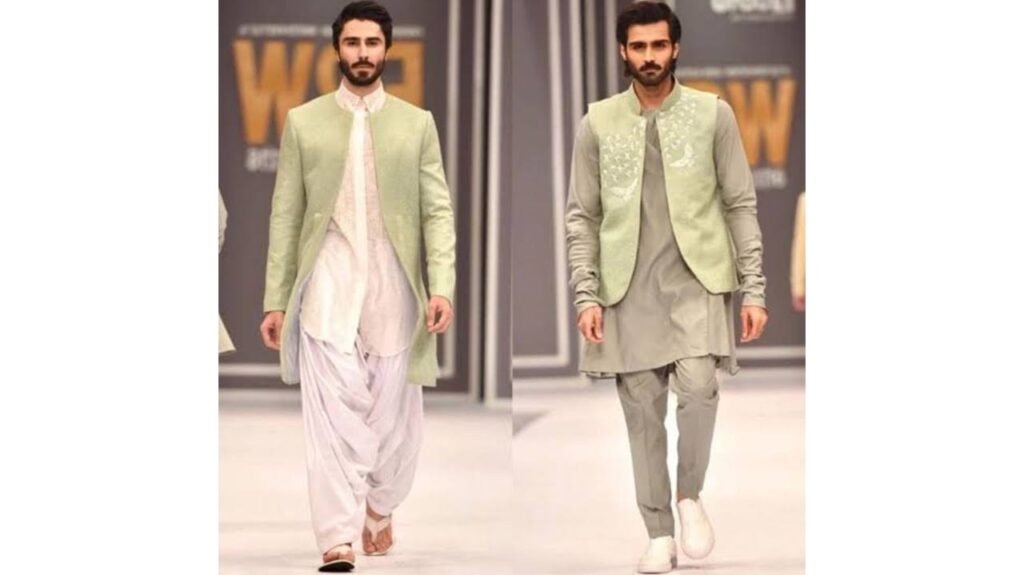
6. Bandhgala
- Origin: The bandhgala, also known as the Jodhpuri suit, is a formal attire with a distinctive button closure.
- Key Characteristics: Typically made of fine fabrics like silk or velvet, the bandhgala is often adorned with intricate embroidery and embellishments.
- Occasions: The bandhgala is a popular choice for weddings, receptions, and other formal events.
- Cultural Significance: The bandhgala is a symbol of elegance and sophistication and is often worn by grooms and other dignitaries.
The Indo-Western Bandhgala is a stylish fusion of traditional Indian attire with modern Western influences. It’s a contemporary interpretation of the classic Bandhgala, a formal Indian garment, offering a unique blend of elegance and modernity.
Key Characteristics:
- Fusion of Styles: The Indo-Western Bandhgala seamlessly merges the classic Bandhgala silhouette with contemporary design elements.
- Modernized Aesthetics: It often incorporates modern fabrics, colors, and embellishments, such as:
- Fabrics: Silk, linen, cotton blends, and even velvet can be used in contemporary interpretations.
- Colors: A wider range of colors beyond traditional ones like black, white, and gold are now explored, including vibrant hues and pastel shades.
- Embellishments: Modern embellishments like sequins, beads, and subtle embroidery add a touch of contemporary flair.
- Silhouette Variations: The traditional Bandhgala silhouette may be slightly modified with variations in length, fit, and collar styles.
- Styling Versatility: Indo-Western Bandhgalas can be styled in various ways:
- Formal Occasions: Paired with tailored trousers, a crisp shirt, and formal shoes for black-tie events or weddings.
- Semi-Formal Events: Styled with jeans or chinos for a more relaxed yet elegant look.
- Casual Wear: Some contemporary designs can even be styled with T-shirts for a more casual, everyday look.
Examples of Indo-Western Bandhgala Elements:
- Asymmetrical Hemlines: A modern twist on the traditional straight hemline.
- Western-Inspired Collars: Incorporating elements like mandarin collars or shawl collars.
- Contrast Panels: Adding panels of contrasting colors or fabrics for a contemporary touch.
- Minimalist Embellishments: Subtle embellishments like threadwork or laser-cut detailing.
Cultural Significance:
- Reflects Evolving Trends: The Indo-Western Bandhgala reflects the evolving fashion landscape in India, showcasing a blend of tradition and modernity.
- Global Appeal: Its fusion aesthetic appeals to a global audience, making it a versatile and stylish choice for men worldwide.
Conclusion:
The Indo-Western Bandhgala is a testament to the dynamic nature of Indian fashion. By blending traditional elements with contemporary influences, it offers a stylish and versatile option for men who appreciate a unique blend of heritage and modernity.

5. Nehru Jacket
- Origin: Named after India’s first Prime Minister, Jawaharlal Nehru, the Nehru jacket is a collarless, hip-length jacket.
- Key Characteristics: Typically made of wool, silk, or cotton, the Nehru jacket is a versatile garment that can be worn over a kurta, shirt, or even a T-shirt.
- Cultural Significance: The Nehru jacket is a symbol of Indian heritage and has become a classic piece of men’s formal wear.
The Nehru Jacket, also known as the “Bandh Gale ka Coat” or the “Indian Achkan,” is a timeless piece of men’s attire that embodies elegance and sophistication.
Origins and History:
- Inspiration from Pandit Nehru: The jacket is named after India’s first Prime Minister, Jawaharlal Nehru, who famously popularized this style.
- Evolution from Traditional Attire: The Nehru jacket draws inspiration from traditional Indian attire like the Achkan and the Sherwani, but with a more simplified and modern silhouette.
- Post-Independence Era: The Nehru jacket gained prominence in the post-independence era, becoming a symbol of modern India and a mark of distinction.
Key Characteristics:
- Collarless Design: The most distinctive feature of the Nehru jacket is its collarless design, often featuring a mandarin collar or a simple band.
- Straight Cut: The jacket typically has a straight cut, offering a clean and elegant look.
- Button Closure: The front closure usually consists of a row of buttons or a zipper.
- Versatile Lengths: Nehru jackets can vary in length, ranging from hip-length to knee-length.
- Fabric Choices: They can be made from a variety of fabrics, including silk, cotton, linen, velvet, and brocade.
Styling the Nehru Jacket:
- Formal Occasions: The Nehru jacket is a classic choice for formal events such as weddings, receptions, and other celebratory occasions. It can be paired with a kurta and churidar, or with a formal shirt and trousers.
- Casual Wear: The Nehru jacket can also be styled for more casual occasions. It can be worn over a T-shirt and jeans for a relaxed yet stylish look.
- Accessorizing: The Nehru jacket can be accessorized with a pocket square, a stole, or a traditional Indian headwear like a turban.
Cultural Significance:
- Symbol of Modern India: The Nehru jacket has become a symbol of modern India, representing a blend of tradition and modernity.
- A Mark of Distinction: It is often worn by dignitaries, politicians, and other prominent figures.
- Enduring Style: The timeless elegance and versatility of the Nehru jacket ensure its enduring popularity in the world of men’s fashion.
Modern Interpretations:
- Contemporary Designs: Designers are constantly experimenting with new styles and fabrics, offering contemporary interpretations of the classic Nehru jacket.
- Fusion Wear: The Nehru jacket is often incorporated into Indo-Western fusion wear, creating unique and stylish looks.
Conclusion:
The Nehru jacket is more than just a garment; it is a symbol of Indian heritage, elegance, and modern style. Its timeless design and versatility ensure that it will continue to be a cherished piece of men’s attire for generations to come.
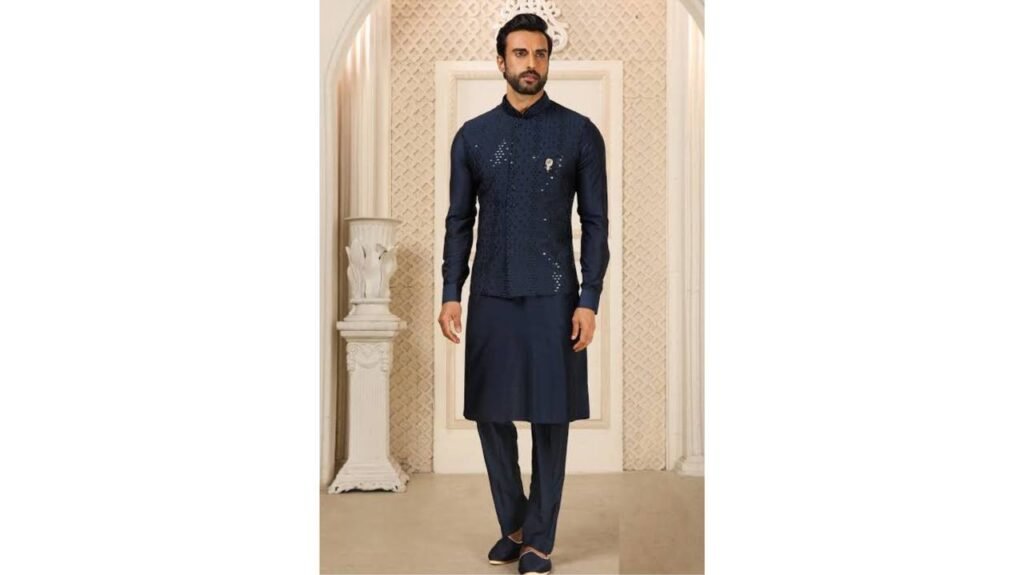
4. Pathani Suit
- Origin: The Pathani suit originated in the North-Western regions of India and Pakistan.
- Key Characteristics: It consists of a long, straight kurta paired with loose-fitting salwar pants.
- Versatility: The Pathani suit is a versatile garment that can be worn for both casual and formal occasions.
- Cultural Significance: The Pathani suit is a popular choice for weddings and festive occasions, particularly in North India.
The Pathani Suit, also known as the Khan Suit or Kabul Suit, is a traditional men’s attire with roots in the Pashtun regions of Afghanistan and Pakistan. It has evolved into a popular choice for men in South Asia, particularly in India, for both everyday wear and special occasions.
Key Characteristics:
- Three-Piece Ensemble: The Pathani suit typically consists of three pieces:
- Kurta: A long, straight-cut tunic that extends below the knees. It often features a simple neckline and long sleeves.
- Salwar: Loose, gathered trousers that are wider at the hips and narrower at the ankles.
- Waistcoat (Optional): A short, sleeveless jacket worn over the kurta.
- Simple Yet Elegant: The Pathani suit is characterized by its simple yet elegant design. It often features minimal embellishments, relying on the quality of the fabric and the clean lines of the silhouette.
- Comfort and Versatility: The loose-fitting nature of the kurta and salwar makes the Pathani suit comfortable to wear in various climates. Its versatility allows it to be adapted for different occasions, from casual outings to formal events.
- Fabric Choices: Pathani suits are typically made from breathable fabrics like cotton, linen, or silk, making them suitable for various seasons.
Cultural Significance:
- Symbol of Heritage: The Pathani suit is deeply rooted in the cultural heritage of the Pashtun people and has become a symbol of their identity.
- Social Status: In some regions, the style and quality of the Pathani suit can also signify social status and wealth.
Modern Interpretations:
- Contemporary Designs: Modern designers have incorporated contemporary elements into the Pathani suit, experimenting with different colors, fabrics, and embellishments.
- Fusion Wear: The Pathani suit has also inspired fusion wear, combining traditional elements with Western styles, such as pairing the kurta with jeans or chinos.
Overall:
The Pathani suit is a timeless and elegant garment that continues to be a popular choice for men in South Asia. Its simple yet sophisticated design, combined with its cultural significance, ensures its enduring appeal.
Disclaimer: This information is for general knowledge and informational purposes only.
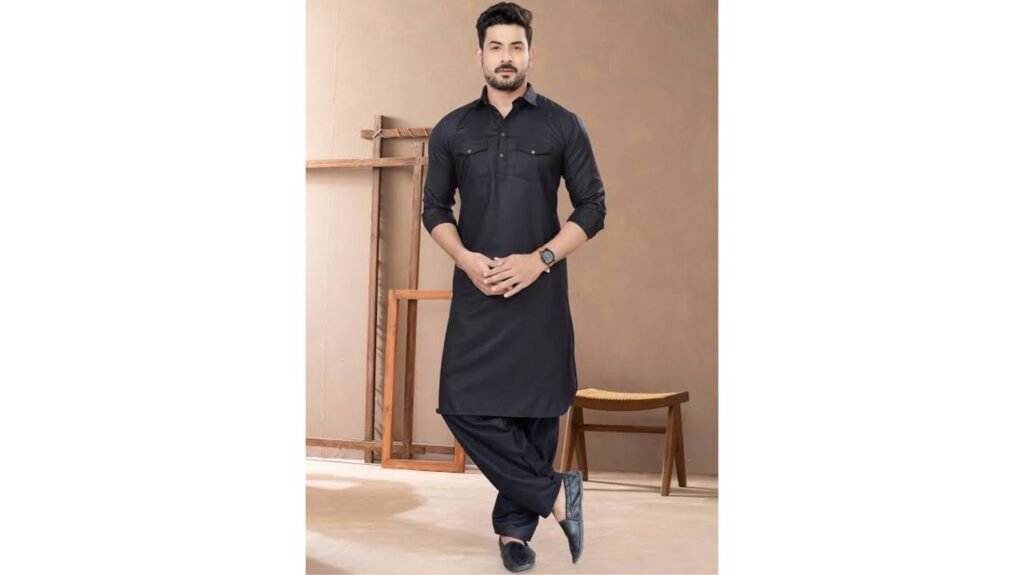
3. Dhoti
- Origin: The dhoti is a traditional Indian garment consisting of a long piece of unstitched cloth wrapped around the waist and legs.
- Key Characteristics: The dhoti is a comfortable and breathable garment, often worn with a kurta or shirt.
- Cultural Significance: The dhoti is deeply rooted in Indian culture and is associated with simplicity, comfort, and tradition.
- Modern Interpretations: Modern interpretations of the dhoti often incorporate contemporary designs and fabrics, making it suitable for both traditional and modern settings.
The dhoti is a traditional Indian garment worn by men, particularly in South Asia. It’s a rectangular piece of unstitched cloth that is draped around the waist and legs, creating a loose, flowing silhouette.
Here’s a deeper dive into the dhoti:
- Origins: The dhoti has a long and rich history, evolving from ancient Indian attire. It’s believed to have originated from the “antariya,” a garment worn in ancient India.
- Materials: Traditionally, dhotis are made from cotton, a breathable and comfortable fabric suitable for the Indian climate. Silk and other fine fabrics are also used for special occasions.
- Draping Styles: The way a dhoti is draped can vary depending on region, occasion, and personal preference. Some common styles include:
- Straight Dhoti: The most common style, where the cloth is wrapped around the waist and legs, creating a simple and elegant look.
- Angrakha Style: The dhoti is draped in a way that creates a diagonal fold across the chest, similar to an angrakha.
- Regional Variations: Different regions in India have their own unique styles of draping the dhoti.
- Cultural Significance:
- Symbol of Tradition: The dhoti is deeply rooted in Indian culture and is often associated with tradition, simplicity, and comfort.
- Religious Significance: It is commonly worn by Hindu priests and monks.
- National Identity: The dhoti has also been a symbol of Indian nationalism and cultural identity.
- Modern Interpretations:
- Dhoti Pants: A modern adaptation of the dhoti, resembling loose-fitting trousers with a draped effect.
- Fusion Wear: The dhoti is incorporated into contemporary fashion, paired with modern shirts or jackets to create unique and stylish looks.
Key Characteristics:
- Comfort: The loose and flowing nature of the dhoti makes it a comfortable garment to wear in hot weather.
- Versatility: While traditionally associated with formal occasions, the dhoti can be adapted for casual wear as well.
- Elegance: When draped elegantly, the dhoti can create a sophisticated and dignified look.
In Conclusion:
The dhoti is a timeless garment that embodies the rich cultural heritage of India. It continues to be an important part of Indian tradition while also evolving to suit modern tastes and lifestyles.
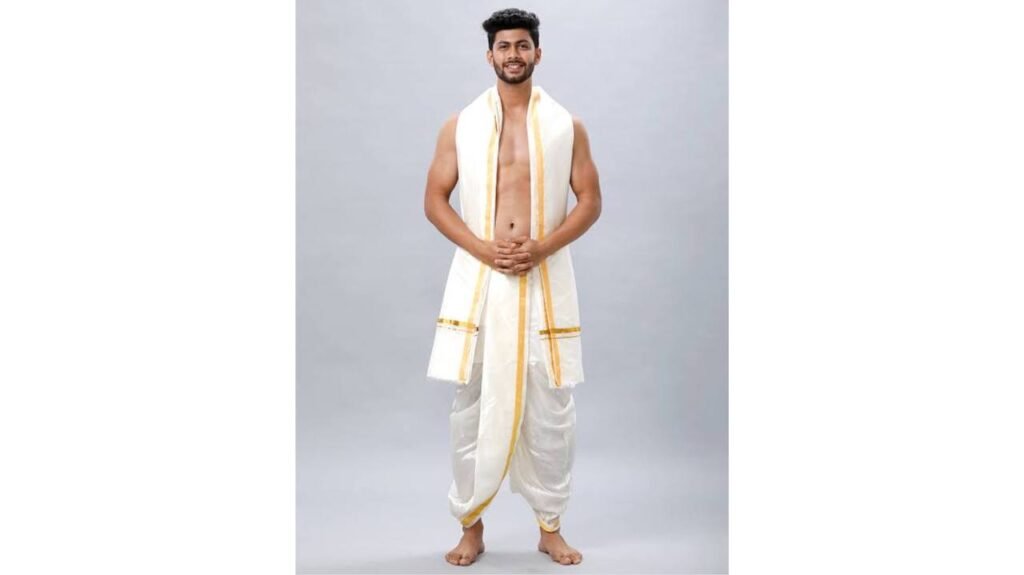
2. Sherwani
- Origin: The sherwani is a long, fitted coat that originated in the Mughal era.
- Key Characteristics: Typically made of rich fabrics like silk, velvet, or brocade, the sherwani is often adorned with intricate embroidery and embellishments.
- Occasions: Traditionally worn by grooms at weddings, the sherwani is also popular for other formal occasions such as receptions and parties.
- Cultural Significance: The sherwani symbolizes elegance, sophistication, and cultural heritage.
The sherwani is a quintessential garment in Indian men’s fashion, embodying elegance, sophistication, and a rich cultural heritage.
Origins and Evolution:
- Mughal Influence: The sherwani has its roots in the Mughal era, evolving from the angarkha, a long, open-fronted coat.
- Royal Origins: Initially worn by royalty and nobility, the sherwani gradually gained popularity among other social classes.
- Modern Interpretations: While retaining its core elements, the sherwani has evolved over time, incorporating modern influences and adapting to changing fashion trends.
Key Characteristics:
- Long and Fitted: The sherwani is a long, knee-length coat with a fitted silhouette, often featuring a buttoned front.
- Collar Variations: It can have a variety of collars, including a stand-up collar, a shirt-style collar, or a collarless design.
- Luxurious Fabrics: Traditionally made from rich fabrics like silk, velvet, brocade, and jacquard, the sherwani often features intricate embroidery, embellishments, and embellishments like zari work and beading.
- Color Palette: While traditionally associated with rich colors like gold, red, and green, modern sherwanis come in a wider range of colors and patterns.
Occasions:
- Weddings: The sherwani is most commonly worn by grooms at weddings, symbolizing elegance and grandeur.
- Formal Events: It is also suitable for other formal occasions such as receptions, parties, and festive celebrations.
- Cultural Events: The sherwani is often worn during cultural events and festivals, showcasing Indian heritage and tradition.
Styling the Sherwani:
- Bottom Wear: The sherwani is typically paired with churidar pants (tight-fitting pants), salwar (loose-fitting pants), or dhoti pants.
- Footwear: Traditionally, sherwanis are paired with embroidered juttis (traditional Indian footwear). However, modern interpretations often include shoes or loafers.
- Accessories: The look can be completed with a safa (turban), a stole, or a brooch.
Cultural Significance:
- Symbol of Elegance: The sherwani is a symbol of elegance, sophistication, and cultural heritage in India.
- Bridal Attire: It holds a special place in Indian weddings, symbolizing the groom’s elegance and the significance of the occasion.
- Reflection of Tradition: The sherwani reflects the rich cultural heritage of India and continues to be a cherished garment, passed down through generations.
Conclusion:
The sherwani is more than just an article of clothing; it is a timeless piece of art that embodies the essence of Indian men’s fashion. Its elegance, sophistication, and cultural significance ensure that the sherwani will continue to be a cherished garment for generations to come.
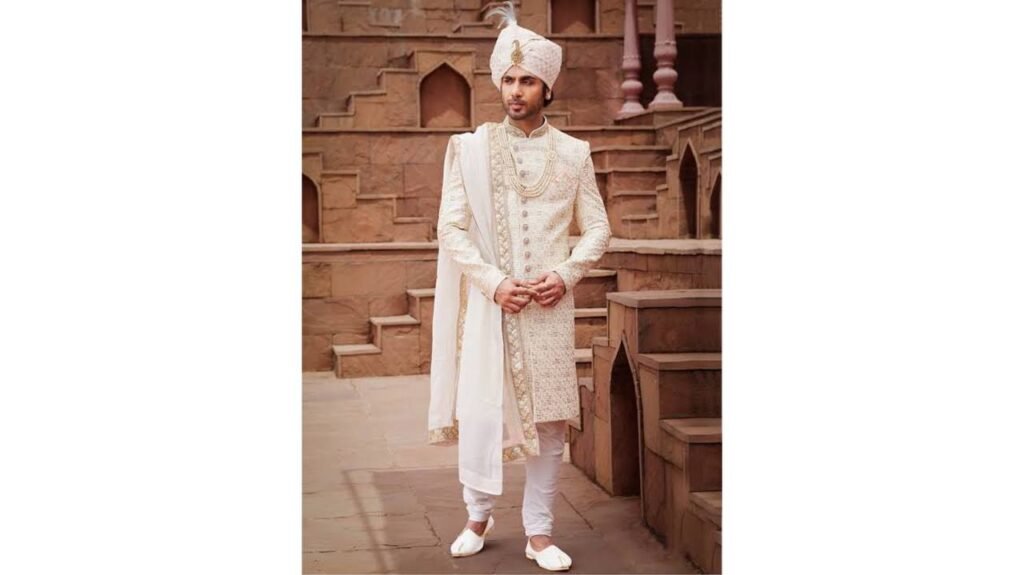
1. Kurta Pyjama
- Origin: The kurta pyjama is perhaps the most ubiquitous and versatile men’s attire in India. It consists of a long, loose-fitting shirt (kurta) paired with loose-fitting trousers (pyjama).
- Key Characteristics: Available in a wide range of fabrics, colors, and designs, the kurta pyjama can be adapted for various occasions, from casual outings to festive celebrations.
- Versatility: The kurta pyjama can be styled in countless ways, paired with a Nehru jacket, a waistcoat, or simply worn as is.
- Cultural Significance: The kurta pyjama is deeply ingrained in Indian culture and represents a comfortable and elegant style.
The kurta pyjama is arguably the most ubiquitous and versatile men’s attire in India, a testament to its enduring appeal and cultural significance.
A Deeper Dive:
- Components:
- Kurta: A long, loose-fitting shirt typically reaching below the knees. It can have a collar (often a Mandarin collar) or be collarless. Sleeves vary from short to full-length.
- Pyjama: Loose-fitting trousers that are comfortable and breathable. They can be straight-cut or have a slight taper towards the ankles.
- Fabric Choices: The choice of fabric significantly influences the look and feel of the kurta pyjama. Common choices include:
- Cotton: Lightweight and breathable, ideal for hot weather.
- Silk: Luxurious and elegant, often used for special occasions.
- Linen: Comfortable and breathable, perfect for summer wear.
- Velvet: Rich and opulent, suitable for winter wear and festive occasions.
- Chiffon: Light and airy, often used for summer kurtas.
- Styling Variations: The versatility of the kurta pyjama lies in its adaptability.
- Casual: Pair a cotton kurta with simple pyjamas and sandals for a relaxed, everyday look.
- Formal: Opt for a silk or velvet kurta with intricate embroidery, paired with elegant pyjamas and leather shoes for a sophisticated look.
- Festive: Choose kurtas with vibrant colors, rich embroidery, and embellishments for weddings and other special occasions.
- Indo-Western: Experiment with Indo-Western fusion by pairing a kurta with jeans, chinos, or even a jacket.
- Cultural Significance:
- Comfort and Convenience: The kurta pyjama offers unparalleled comfort and ease of movement, making it suitable for various activities.
- Versatility: Its adaptability to different occasions and styles makes it a wardrobe staple for men of all ages.
- Cultural Identity: The kurta pyjama is deeply ingrained in Indian culture, representing a blend of tradition and comfort.
- Modern Interpretations: Designers are constantly reimagining the kurta pyjama, incorporating contemporary elements like asymmetrical cuts, bold prints, and innovative fabrics, while retaining its core essence.
In essence: The kurta pyjama is more than just an outfit; it’s a cultural symbol, a statement of style, and a testament to the enduring appeal of traditional Indian attire.
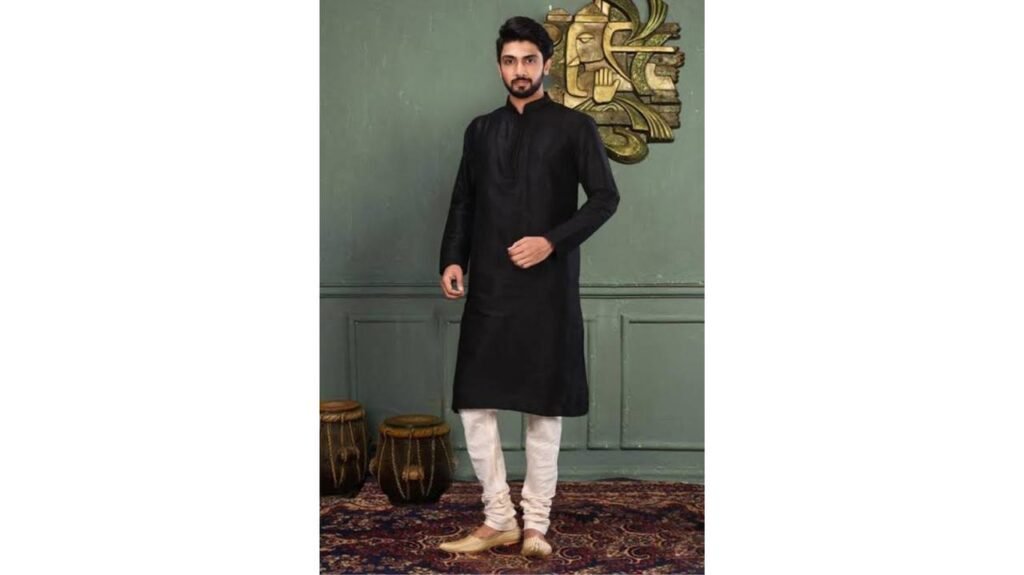
Conclusion:
These ten garments represent a diverse range of styles, each with its own unique history and cultural significance. From the timeless elegance of the sherwani to the comfort of the kurta pyjama, these dresses have shaped the landscape of men’s fashion in India. They continue to evolve, adapting to changing trends while retaining their core essence and cultural significance.
Disclaimer: This list is not exhaustive, and the most famous dresses for men in India will vary depending on individual preferences and cultural contexts.

